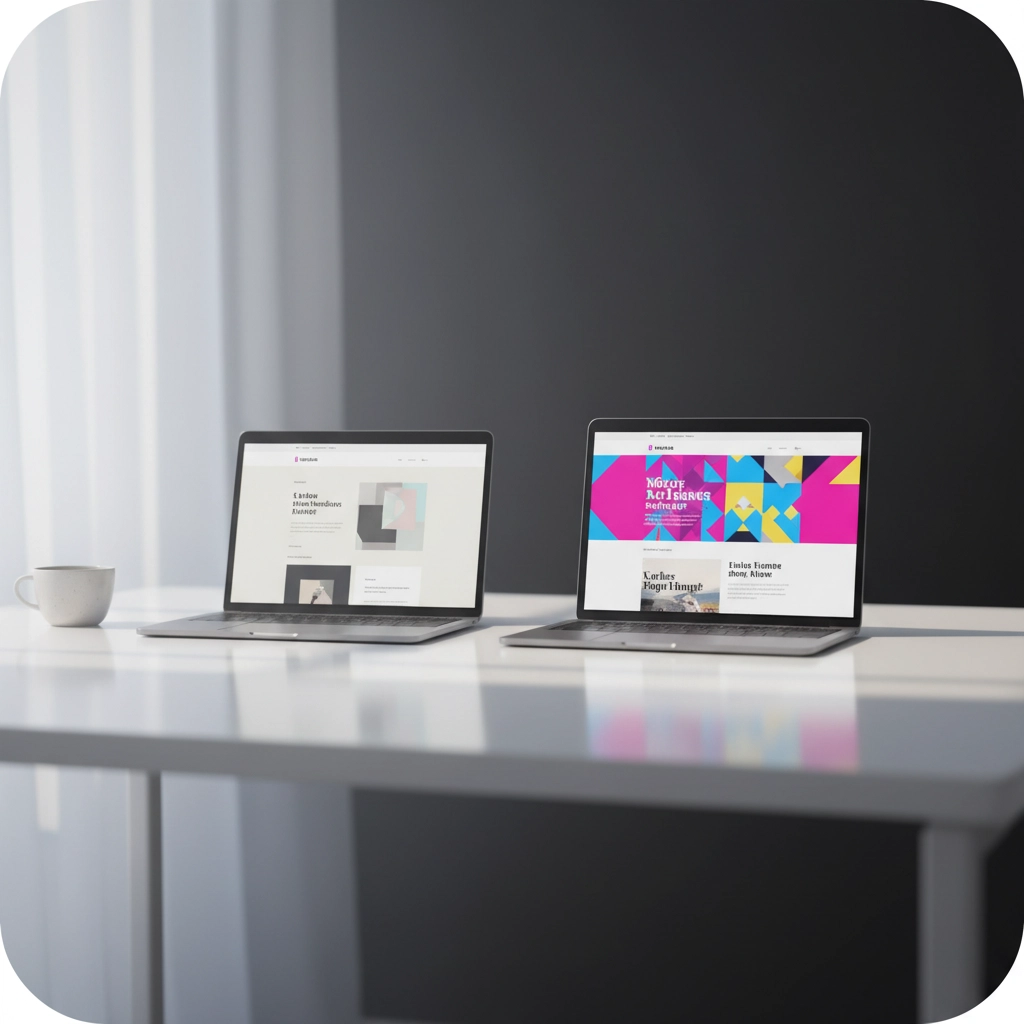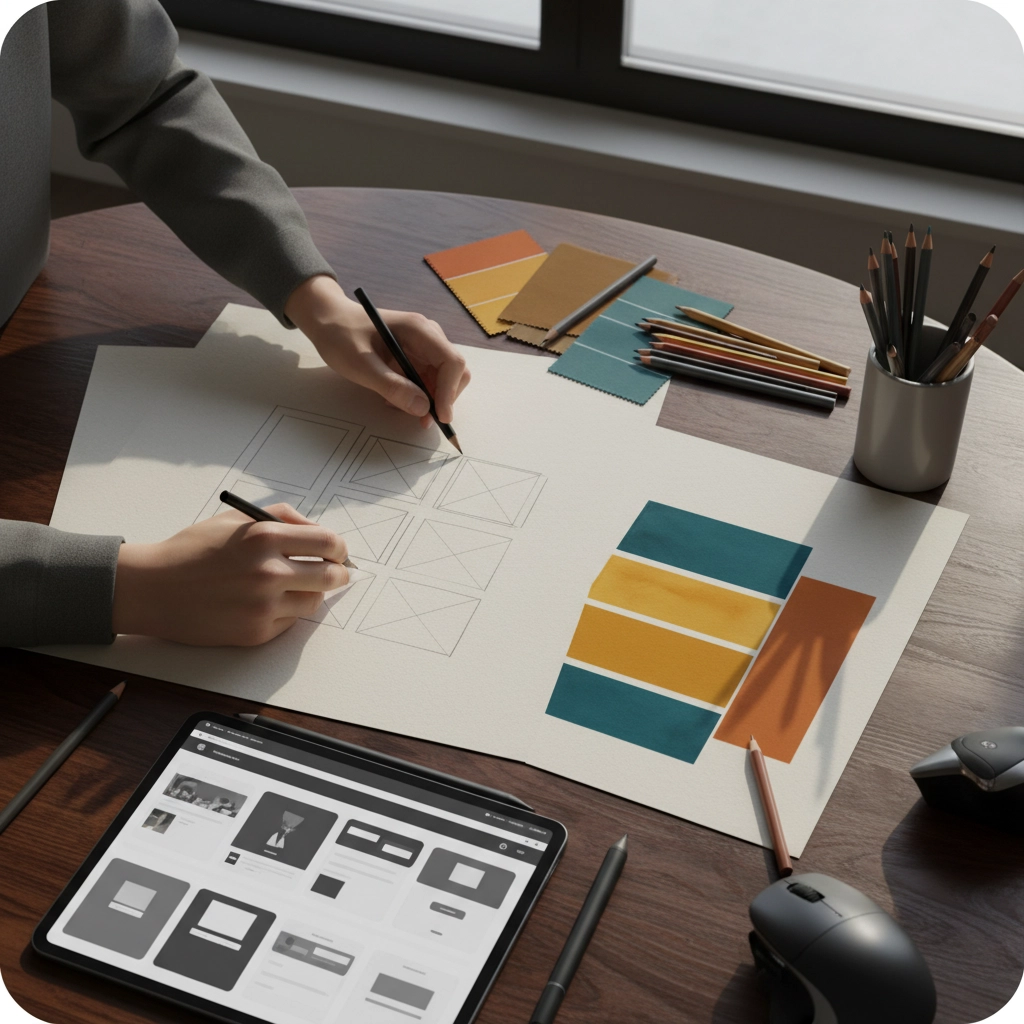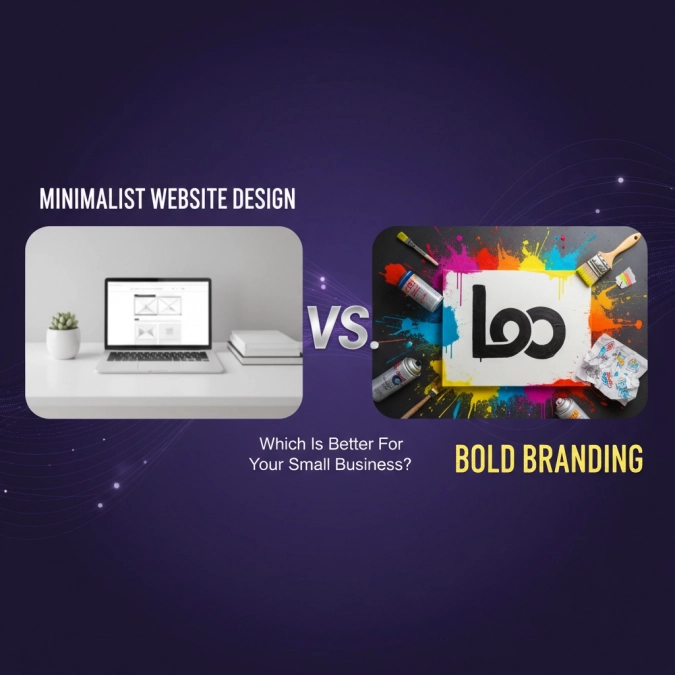You're staring at competitor websites again, aren't you? Half of them look like they were designed by someone who's afraid of colour, while the others assault your eyes with every shade of the rainbow. Your cursor hovers over the 'Contact Designer' button, but you're paralysed by a simple question: should your small business website whisper with minimalist elegance or shout with bold personality?
The answer isn't what you think. Neither approach wins by default: but one will definitely work better for your specific situation.
Minimalist Design Builds Trust Through Clarity
Minimalist website design strips everything down to essentials. Clean layouts, neutral colours, elegant typography, and strategic white space create an atmosphere of sophistication and professionalism. This isn't about being boring: it's about being purposeful with every element.
The practical benefits hit your bottom line immediately. Minimalist sites load faster because there are fewer design elements competing for bandwidth. They adapt seamlessly to mobile devices without complex responsive adjustments. Navigation becomes intuitive, and your calls-to-action stand out because there's nothing else demanding attention.

Industries that thrive with minimalism:
- Healthcare and pharmaceutical companies
- Legal and financial services
- Technology and software businesses
- Educational institutions
- Professional consulting firms
These sectors serve clients who need to feel confident in your expertise. When someone's searching for a lawyer or medical professional, they want competence and trustworthiness: not creative flair. Minimalism communicates these qualities instantly.
But minimalism carries hidden risks. Without careful execution, your brand disappears into generic territory. Every minimalist site starts looking identical: white backgrounds, sans-serif fonts, and sparse layouts that could belong to anyone. You risk becoming forgettable in pursuit of being timeless.
Bold Branding Creates Memorable Emotional Connections
Bold design takes the opposite approach. Vibrant colours, striking typography, creative layouts, and dynamic elements create visual impact that stops visitors mid-scroll. This style doesn't just communicate information: it creates an experience that people remember.
The psychology behind bold branding is simple: humans remember things that surprise them. When your website challenges expectations and takes visitors on a visual journey, you're not just another business: you become a brand worth talking about.
Bold branding excels for:
- Creative agencies and design studios
- Fashion and lifestyle brands
- Entertainment and event companies
- Restaurants and hospitality businesses
- Art and photography portfolios
These industries sell experiences, emotions, and aspirations. Your website needs to demonstrate your creative capabilities while evoking the feelings your services provide. Bold design does both simultaneously.
The danger lies in execution. Too many colours, excessive animations, and chaotic layouts don't look bold: they look amateur. Poor bold design makes visitors question your judgement and professionalism.
The Real Comparison: Performance vs Personality
| Factor | Minimalist Design | Bold Branding |
|---|---|---|
| Load Speed | Faster (fewer elements) | Slower (complex graphics) |
| Mobile Experience | Excellent adaptation | Requires careful optimisation |
| Brand Recall | Good through clarity | Excellent through distinctiveness |
| User Trust | High professional credibility | High emotional engagement |
| Maintenance | Simple updates | Complex design management |
| Conversion Rate | Strong CTAs, less distraction | Emotional connection drives action |
| Industry Fit | Professional services | Creative and lifestyle sectors |
| Longevity | Timeless appeal | Trend-dependent |
The Hybrid Approach Wins Most Battles
Smart small businesses don't choose sides: they combine the best elements of both approaches. Start with a minimalist structure that ensures fast loading and clear navigation, then add bold highlights strategically.
Use neutral backgrounds and clean layouts as your foundation. Then inject personality through vibrant accent colours on call-to-action buttons, bold typography for headlines, and carefully placed graphic elements that support your message without overwhelming it.

This balanced approach gives you clarity and personality. Your site loads quickly and converts well while still expressing your brand's unique character. Even the boldest designs benefit from strategic whitespace that prevents visual chaos.
Consider how you can layer personality onto minimalist bones:
- Clean layout with one signature brand colour as an accent
- Minimalist body text with bold, expressive headlines
- Simple navigation with creative hover effects
- Neutral backgrounds with strategic pops of vibrant imagery
Choose Your Strategy Based on Your Reality
Go minimalist when your small business:
Your clients are making high-stakes decisions. Legal services, healthcare, financial consulting, and B2B software companies need to project competence above creativity. Your audience values expertise, reliability, and clear communication over visual excitement.
You have limited resources for ongoing design maintenance. Minimalist sites require fewer updates and remain functional longer. Complex bold designs need regular refreshing to avoid looking outdated.
Your content is the star. Blogs, educational sites, and information-heavy businesses benefit from designs that enhance readability rather than competing for attention.
Choose bold branding when your small business:
You're competing in saturated creative markets. Design agencies, photographers, fashion brands, and lifestyle businesses need to differentiate dramatically. Your portfolio is your marketing, and bland won't cut through the noise.
Your audience expects creativity and personality. Younger demographics and trend-conscious consumers want brands that reflect their values and aesthetic preferences. Generic minimalism feels disconnected from their reality.
You sell experiences over products. Restaurants, event planners, travel companies, and entertainment businesses need to evoke emotions and create anticipation. Bold design demonstrates the experience you deliver.
Go hybrid when your small business:
You need both credibility and personality. Many successful small businesses serve diverse audiences with varying expectations. A law firm targeting young entrepreneurs needs professionalism and approachability.
You want future flexibility. Hybrid approaches adapt more easily as your business evolves. You can emphasise minimalist elements when targeting corporate clients and amplify bold elements for consumer marketing.
Your Decision Framework
Stop overthinking the aesthetics and focus on your business reality. Ask yourself these questions:
What emotional state are your potential clients in when they find your website? Stressed legal clients need calm reassurance. Excited couples planning weddings want creative inspiration. Your design should match their mindset.
How complex is your decision-making process? Simple purchases can handle bold, emotional design. Complex B2B sales cycles require clear, professional presentations of information.
What does your competition look like? In industries where everyone looks the same, differentiation matters more than convention. In professional sectors where trust is paramount, deviation from norms can backfire.
The best website design for your small business isn't about following trends: it's about serving your specific audience's needs while expressing your authentic brand personality. Whether that's minimalist, bold, or somewhere in between depends entirely on who you serve and how you want to serve them.
Choose the approach that makes your ideal clients feel understood, confident, and ready to take action. That's where good design becomes great business strategy.
If you're ready to start your digital journey, get in touch.

